Assessment 2: Economics for Managers - Market Structures Analysis
VerifiedAdded on 2020/02/24
|24
|4404
|34
Report
AI Summary
This report provides a comprehensive analysis of four market structures: monopoly, oligopoly, monopolistic competition, and perfect competition. It describes the key features of each market structure, including the number of firms, type of product, control over price, and conditions of entry. The report utilizes diagrams to illustrate short-run and long-run profits and losses in each market structure. Furthermore, it compares resource allocation across the four market types. The study also includes a brief description of negative externalities and uses a case study from Australia to demonstrate their impact and government interventions. Finally, the report investigates the effects of externalities on monopoly and perfectly competitive market outcomes, offering a detailed exploration of economic concepts and their real-world applications.
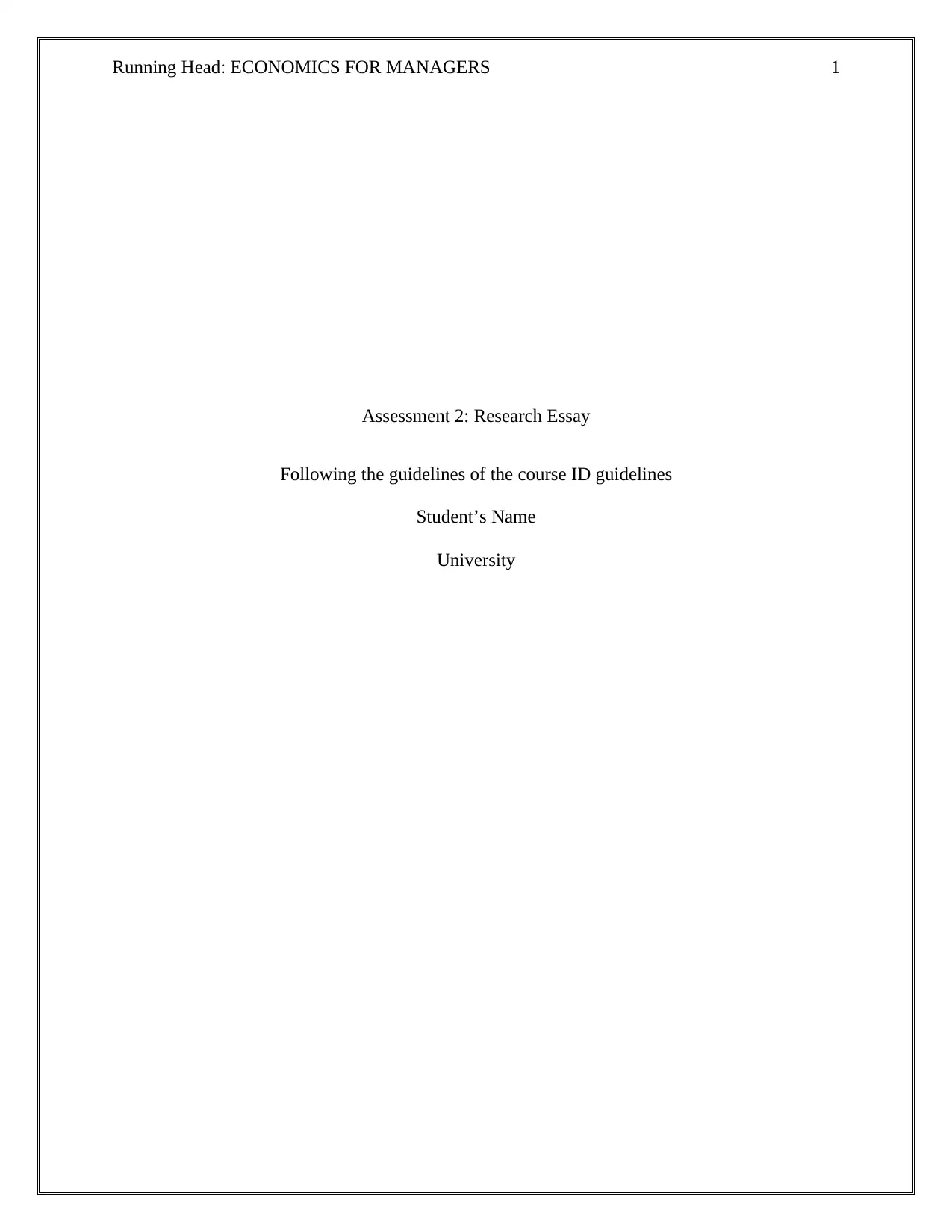
Running Head: ECONOMICS FOR MANAGERS 1
Assessment 2: Research Essay
Following the guidelines of the course ID guidelines
Student’s Name
University
Assessment 2: Research Essay
Following the guidelines of the course ID guidelines
Student’s Name
University
Paraphrase This Document
Need a fresh take? Get an instant paraphrase of this document with our AI Paraphraser
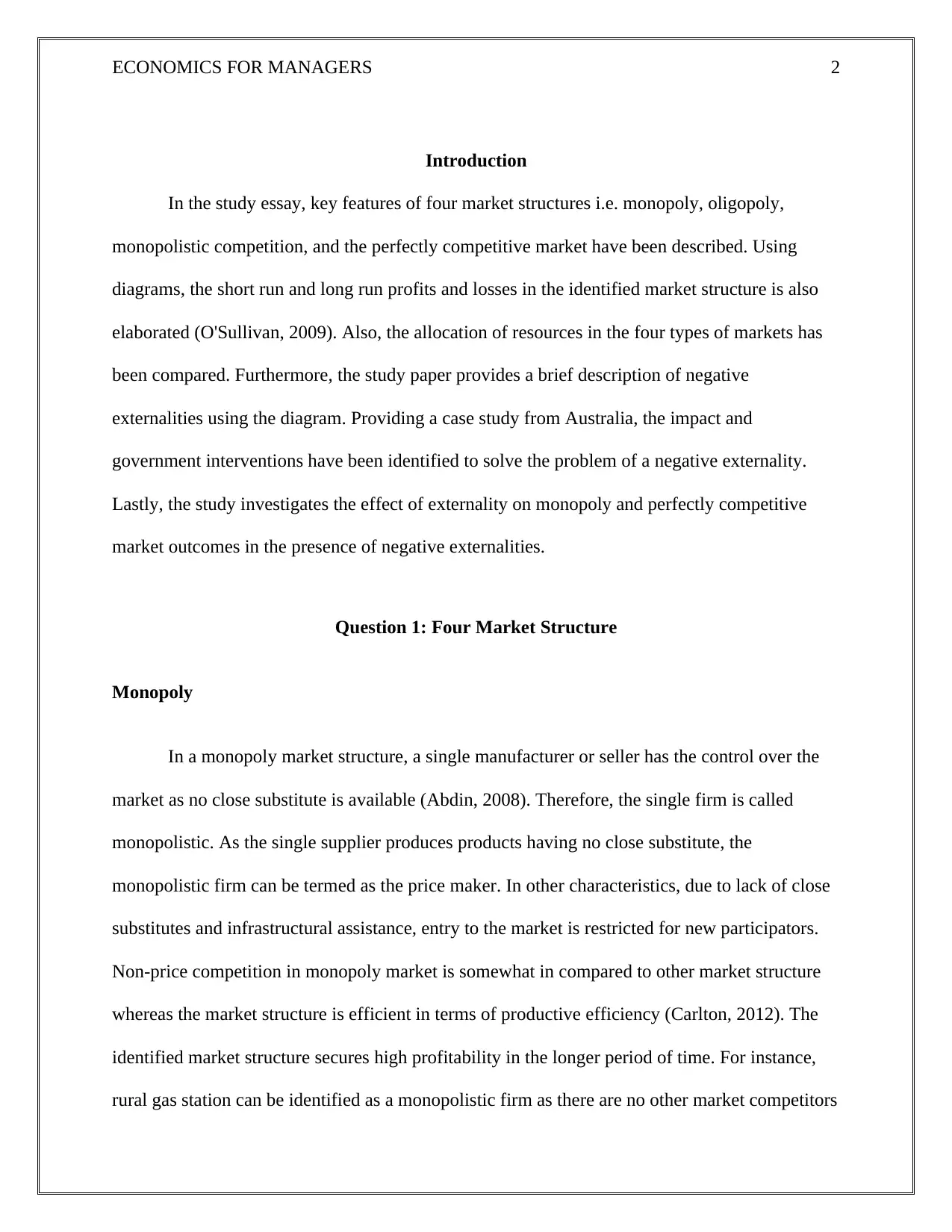
ECONOMICS FOR MANAGERS 2
Introduction
In the study essay, key features of four market structures i.e. monopoly, oligopoly,
monopolistic competition, and the perfectly competitive market have been described. Using
diagrams, the short run and long run profits and losses in the identified market structure is also
elaborated (O'Sullivan, 2009). Also, the allocation of resources in the four types of markets has
been compared. Furthermore, the study paper provides a brief description of negative
externalities using the diagram. Providing a case study from Australia, the impact and
government interventions have been identified to solve the problem of a negative externality.
Lastly, the study investigates the effect of externality on monopoly and perfectly competitive
market outcomes in the presence of negative externalities.
Question 1: Four Market Structure
Monopoly
In a monopoly market structure, a single manufacturer or seller has the control over the
market as no close substitute is available (Abdin, 2008). Therefore, the single firm is called
monopolistic. As the single supplier produces products having no close substitute, the
monopolistic firm can be termed as the price maker. In other characteristics, due to lack of close
substitutes and infrastructural assistance, entry to the market is restricted for new participators.
Non-price competition in monopoly market is somewhat in compared to other market structure
whereas the market structure is efficient in terms of productive efficiency (Carlton, 2012). The
identified market structure secures high profitability in the longer period of time. For instance,
rural gas station can be identified as a monopolistic firm as there are no other market competitors
Introduction
In the study essay, key features of four market structures i.e. monopoly, oligopoly,
monopolistic competition, and the perfectly competitive market have been described. Using
diagrams, the short run and long run profits and losses in the identified market structure is also
elaborated (O'Sullivan, 2009). Also, the allocation of resources in the four types of markets has
been compared. Furthermore, the study paper provides a brief description of negative
externalities using the diagram. Providing a case study from Australia, the impact and
government interventions have been identified to solve the problem of a negative externality.
Lastly, the study investigates the effect of externality on monopoly and perfectly competitive
market outcomes in the presence of negative externalities.
Question 1: Four Market Structure
Monopoly
In a monopoly market structure, a single manufacturer or seller has the control over the
market as no close substitute is available (Abdin, 2008). Therefore, the single firm is called
monopolistic. As the single supplier produces products having no close substitute, the
monopolistic firm can be termed as the price maker. In other characteristics, due to lack of close
substitutes and infrastructural assistance, entry to the market is restricted for new participators.
Non-price competition in monopoly market is somewhat in compared to other market structure
whereas the market structure is efficient in terms of productive efficiency (Carlton, 2012). The
identified market structure secures high profitability in the longer period of time. For instance,
rural gas station can be identified as a monopolistic firm as there are no other market competitors
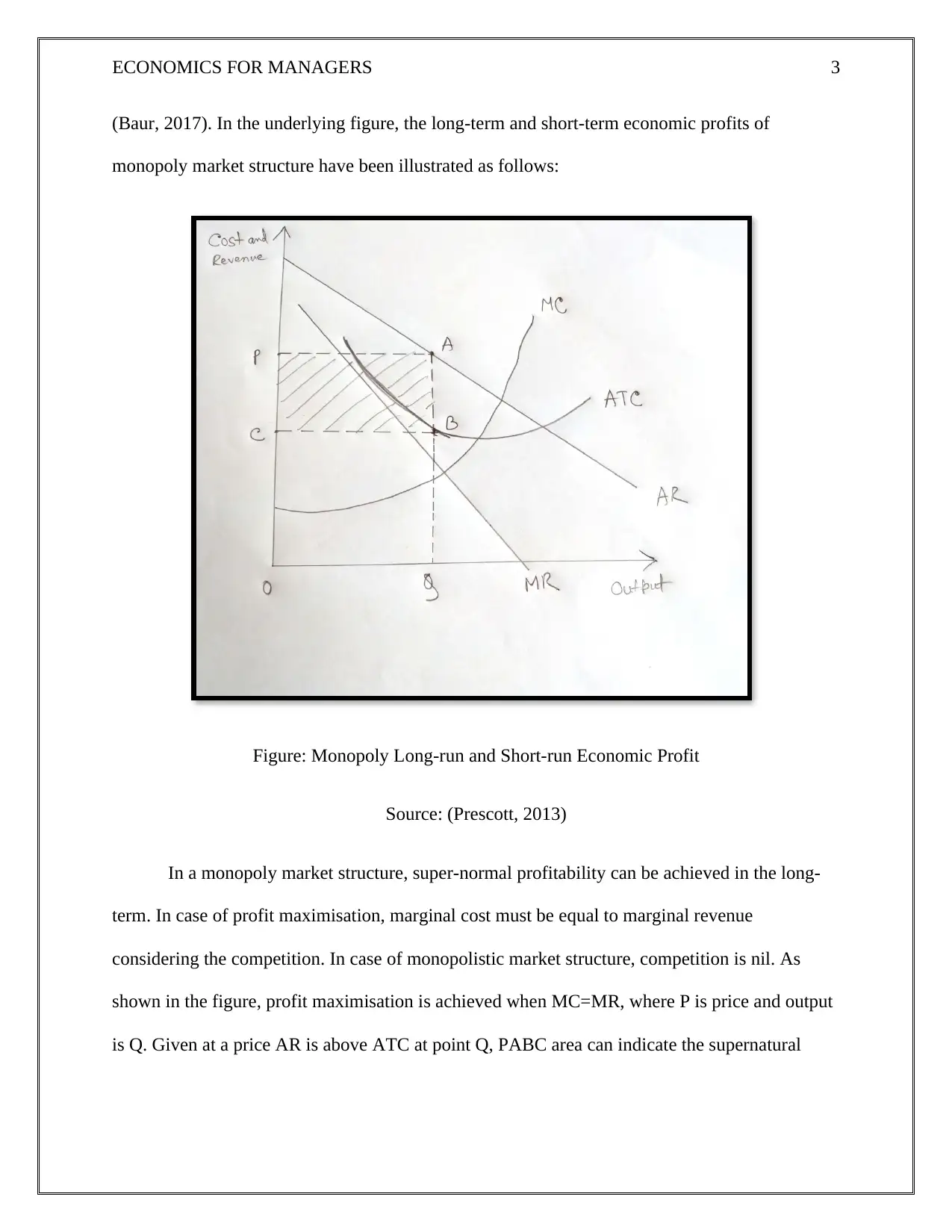
ECONOMICS FOR MANAGERS 3
(Baur, 2017). In the underlying figure, the long-term and short-term economic profits of
monopoly market structure have been illustrated as follows:
Figure: Monopoly Long-run and Short-run Economic Profit
Source: (Prescott, 2013)
In a monopoly market structure, super-normal profitability can be achieved in the long-
term. In case of profit maximisation, marginal cost must be equal to marginal revenue
considering the competition. In case of monopolistic market structure, competition is nil. As
shown in the figure, profit maximisation is achieved when MC=MR, where P is price and output
is Q. Given at a price AR is above ATC at point Q, PABC area can indicate the supernatural
(Baur, 2017). In the underlying figure, the long-term and short-term economic profits of
monopoly market structure have been illustrated as follows:
Figure: Monopoly Long-run and Short-run Economic Profit
Source: (Prescott, 2013)
In a monopoly market structure, super-normal profitability can be achieved in the long-
term. In case of profit maximisation, marginal cost must be equal to marginal revenue
considering the competition. In case of monopolistic market structure, competition is nil. As
shown in the figure, profit maximisation is achieved when MC=MR, where P is price and output
is Q. Given at a price AR is above ATC at point Q, PABC area can indicate the supernatural
⊘ This is a preview!⊘
Do you want full access?
Subscribe today to unlock all pages.

Trusted by 1+ million students worldwide
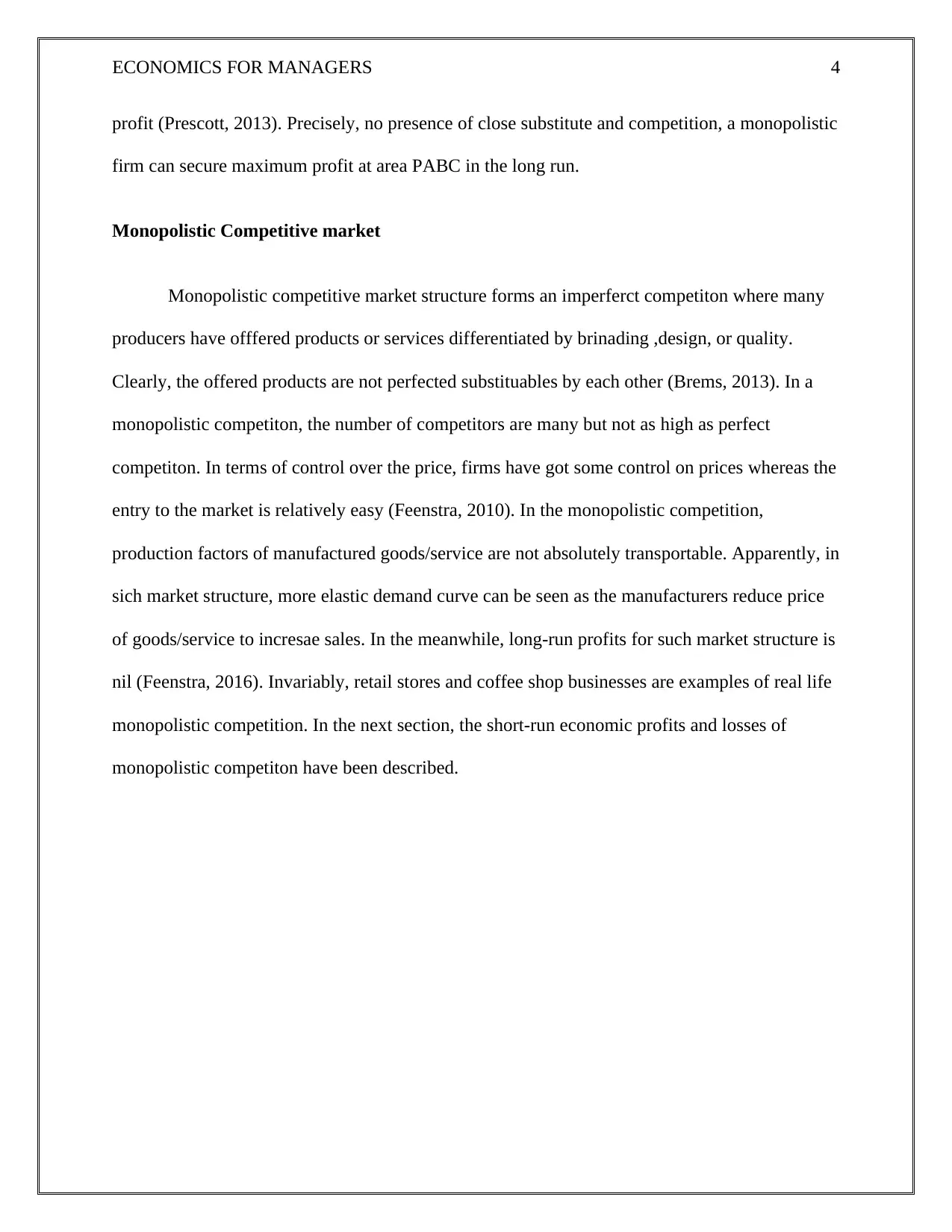
ECONOMICS FOR MANAGERS 4
profit (Prescott, 2013). Precisely, no presence of close substitute and competition, a monopolistic
firm can secure maximum profit at area PABC in the long run.
Monopolistic Competitive market
Monopolistic competitive market structure forms an imperferct competiton where many
producers have offfered products or services differentiated by brinading ,design, or quality.
Clearly, the offered products are not perfected substituables by each other (Brems, 2013). In a
monopolistic competiton, the number of competitors are many but not as high as perfect
competiton. In terms of control over the price, firms have got some control on prices whereas the
entry to the market is relatively easy (Feenstra, 2010). In the monopolistic competition,
production factors of manufactured goods/service are not absolutely transportable. Apparently, in
sich market structure, more elastic demand curve can be seen as the manufacturers reduce price
of goods/service to incresae sales. In the meanwhile, long-run profits for such market structure is
nil (Feenstra, 2016). Invariably, retail stores and coffee shop businesses are examples of real life
monopolistic competition. In the next section, the short-run economic profits and losses of
monopolistic competiton have been described.
profit (Prescott, 2013). Precisely, no presence of close substitute and competition, a monopolistic
firm can secure maximum profit at area PABC in the long run.
Monopolistic Competitive market
Monopolistic competitive market structure forms an imperferct competiton where many
producers have offfered products or services differentiated by brinading ,design, or quality.
Clearly, the offered products are not perfected substituables by each other (Brems, 2013). In a
monopolistic competiton, the number of competitors are many but not as high as perfect
competiton. In terms of control over the price, firms have got some control on prices whereas the
entry to the market is relatively easy (Feenstra, 2010). In the monopolistic competition,
production factors of manufactured goods/service are not absolutely transportable. Apparently, in
sich market structure, more elastic demand curve can be seen as the manufacturers reduce price
of goods/service to incresae sales. In the meanwhile, long-run profits for such market structure is
nil (Feenstra, 2016). Invariably, retail stores and coffee shop businesses are examples of real life
monopolistic competition. In the next section, the short-run economic profits and losses of
monopolistic competiton have been described.
Paraphrase This Document
Need a fresh take? Get an instant paraphrase of this document with our AI Paraphraser
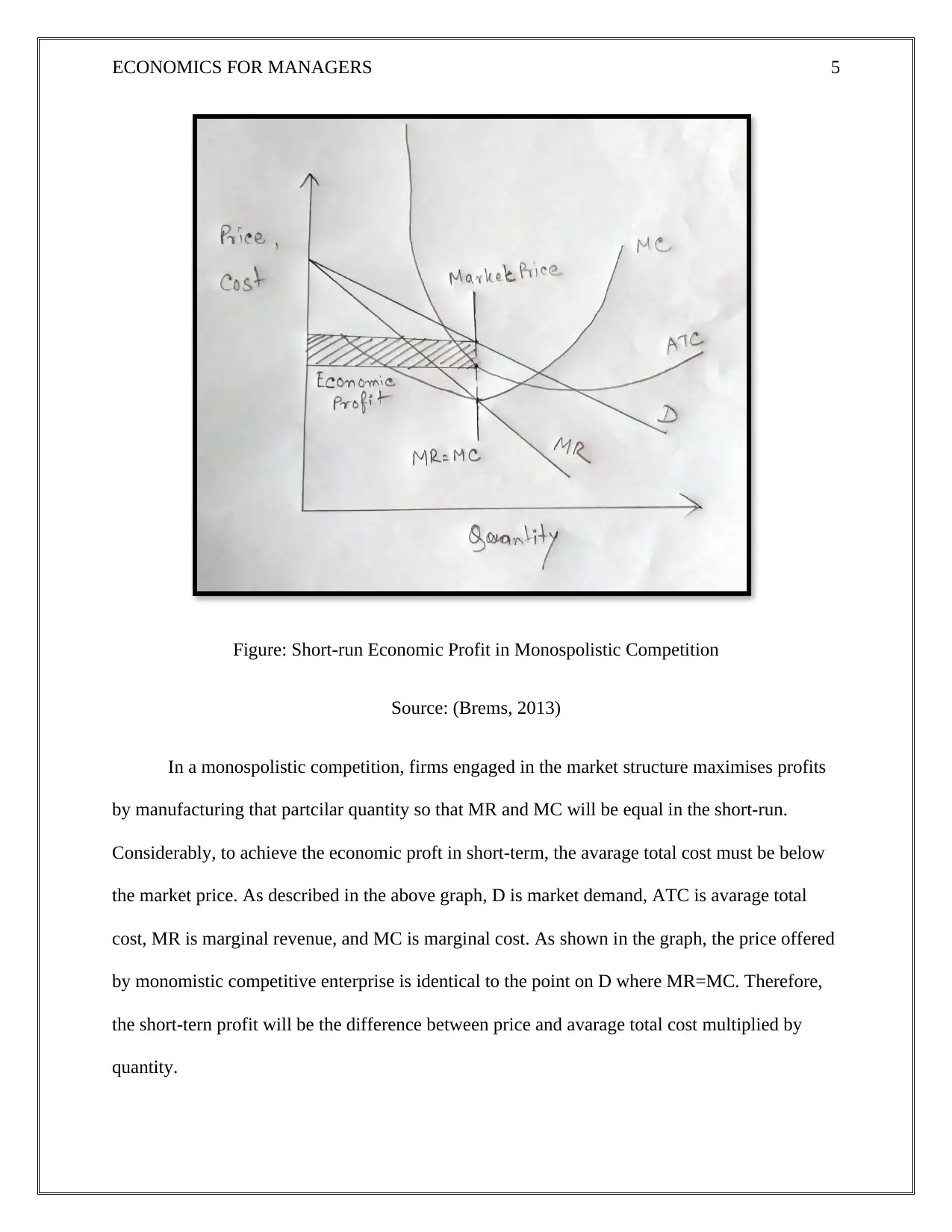
ECONOMICS FOR MANAGERS 5
Figure: Short-run Economic Profit in Monospolistic Competition
Source: (Brems, 2013)
In a monospolistic competition, firms engaged in the market structure maximises profits
by manufacturing that partcilar quantity so that MR and MC will be equal in the short-run.
Considerably, to achieve the economic proft in short-term, the avarage total cost must be below
the market price. As described in the above graph, D is market demand, ATC is avarage total
cost, MR is marginal revenue, and MC is marginal cost. As shown in the graph, the price offered
by monomistic competitive enterprise is identical to the point on D where MR=MC. Therefore,
the short-tern profit will be the difference between price and avarage total cost multiplied by
quantity.
Figure: Short-run Economic Profit in Monospolistic Competition
Source: (Brems, 2013)
In a monospolistic competition, firms engaged in the market structure maximises profits
by manufacturing that partcilar quantity so that MR and MC will be equal in the short-run.
Considerably, to achieve the economic proft in short-term, the avarage total cost must be below
the market price. As described in the above graph, D is market demand, ATC is avarage total
cost, MR is marginal revenue, and MC is marginal cost. As shown in the graph, the price offered
by monomistic competitive enterprise is identical to the point on D where MR=MC. Therefore,
the short-tern profit will be the difference between price and avarage total cost multiplied by
quantity.
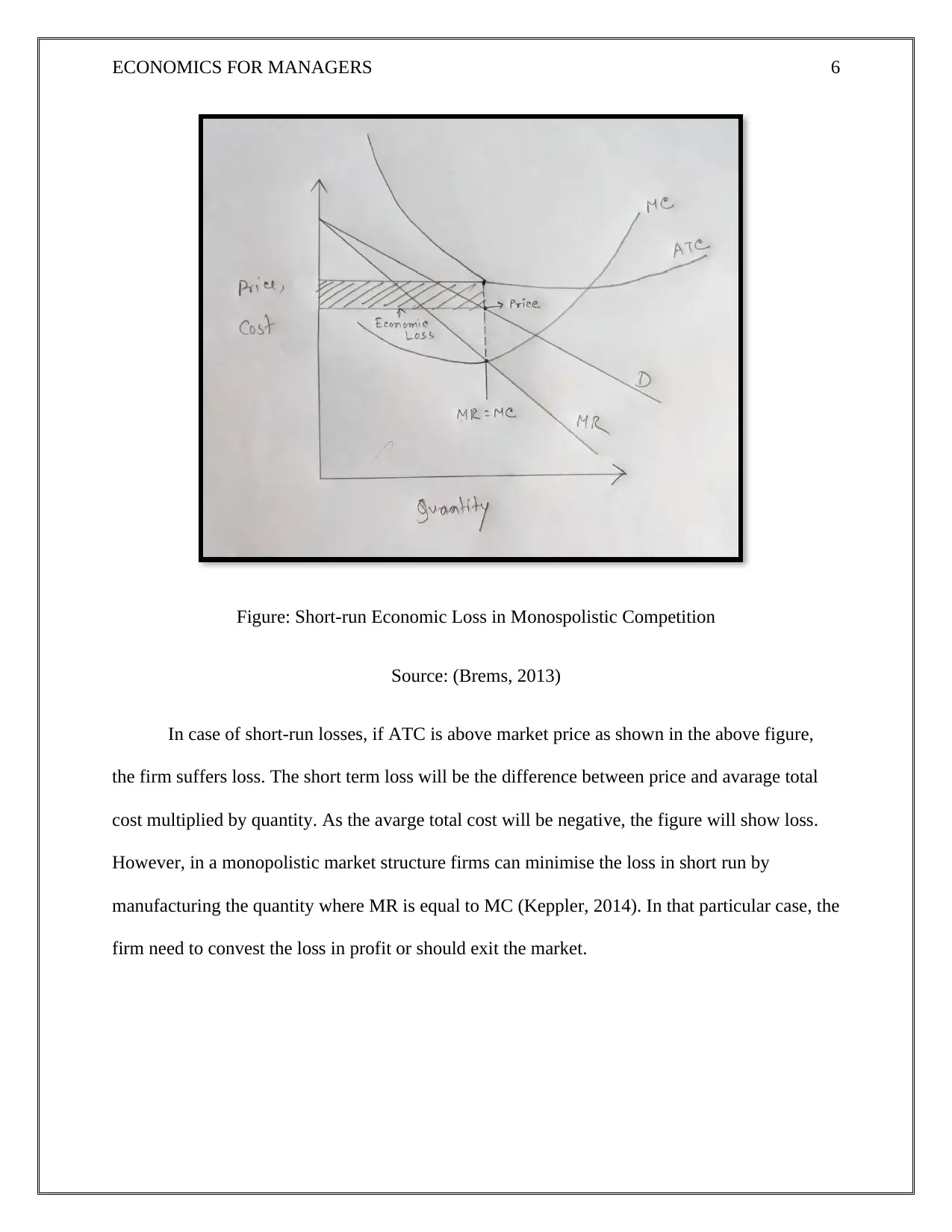
ECONOMICS FOR MANAGERS 6
Figure: Short-run Economic Loss in Monospolistic Competition
Source: (Brems, 2013)
In case of short-run losses, if ATC is above market price as shown in the above figure,
the firm suffers loss. The short term loss will be the difference between price and avarage total
cost multiplied by quantity. As the avarge total cost will be negative, the figure will show loss.
However, in a monopolistic market structure firms can minimise the loss in short run by
manufacturing the quantity where MR is equal to MC (Keppler, 2014). In that particular case, the
firm need to convest the loss in profit or should exit the market.
Figure: Short-run Economic Loss in Monospolistic Competition
Source: (Brems, 2013)
In case of short-run losses, if ATC is above market price as shown in the above figure,
the firm suffers loss. The short term loss will be the difference between price and avarage total
cost multiplied by quantity. As the avarge total cost will be negative, the figure will show loss.
However, in a monopolistic market structure firms can minimise the loss in short run by
manufacturing the quantity where MR is equal to MC (Keppler, 2014). In that particular case, the
firm need to convest the loss in profit or should exit the market.
⊘ This is a preview!⊘
Do you want full access?
Subscribe today to unlock all pages.

Trusted by 1+ million students worldwide
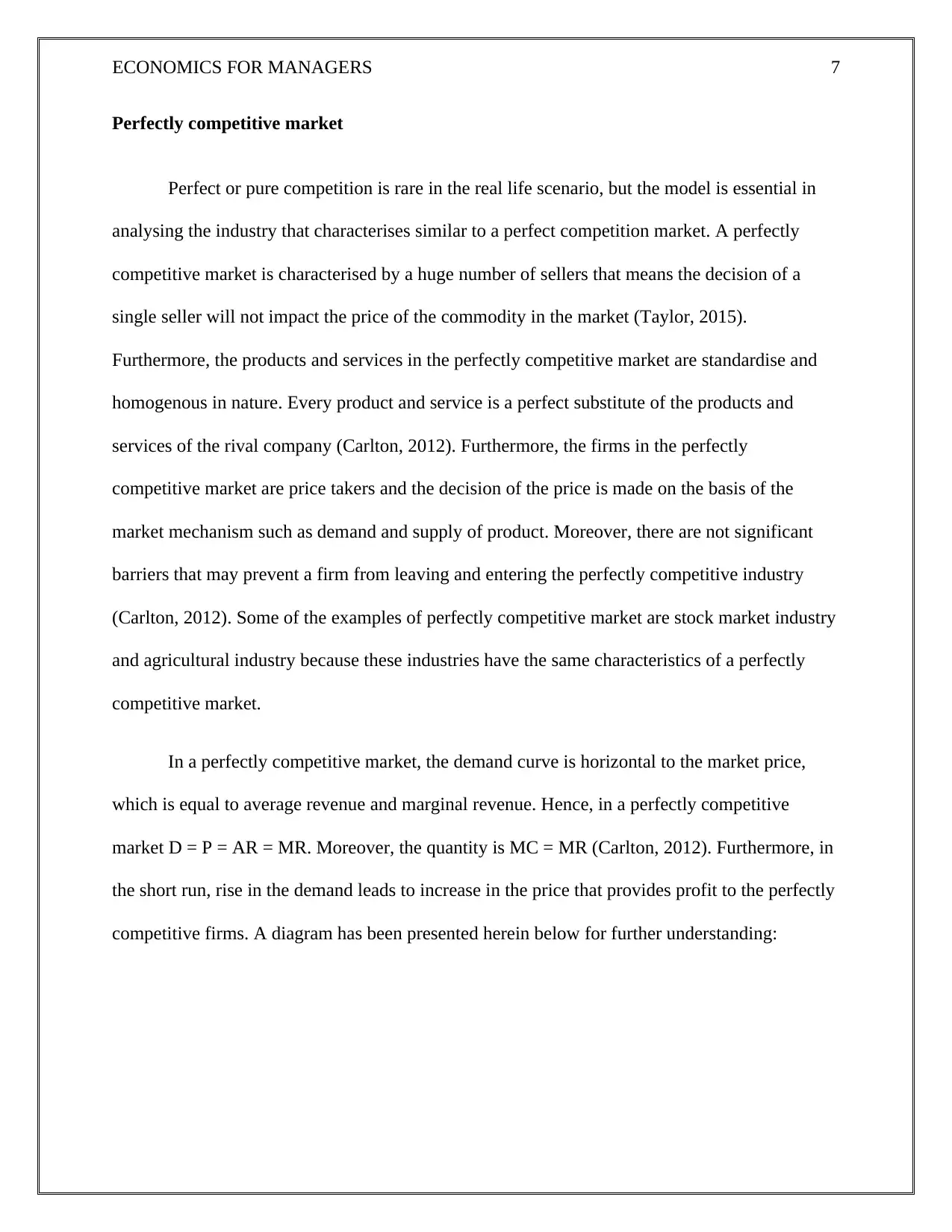
ECONOMICS FOR MANAGERS 7
Perfectly competitive market
Perfect or pure competition is rare in the real life scenario, but the model is essential in
analysing the industry that characterises similar to a perfect competition market. A perfectly
competitive market is characterised by a huge number of sellers that means the decision of a
single seller will not impact the price of the commodity in the market (Taylor, 2015).
Furthermore, the products and services in the perfectly competitive market are standardise and
homogenous in nature. Every product and service is a perfect substitute of the products and
services of the rival company (Carlton, 2012). Furthermore, the firms in the perfectly
competitive market are price takers and the decision of the price is made on the basis of the
market mechanism such as demand and supply of product. Moreover, there are not significant
barriers that may prevent a firm from leaving and entering the perfectly competitive industry
(Carlton, 2012). Some of the examples of perfectly competitive market are stock market industry
and agricultural industry because these industries have the same characteristics of a perfectly
competitive market.
In a perfectly competitive market, the demand curve is horizontal to the market price,
which is equal to average revenue and marginal revenue. Hence, in a perfectly competitive
market D = P = AR = MR. Moreover, the quantity is MC = MR (Carlton, 2012). Furthermore, in
the short run, rise in the demand leads to increase in the price that provides profit to the perfectly
competitive firms. A diagram has been presented herein below for further understanding:
Perfectly competitive market
Perfect or pure competition is rare in the real life scenario, but the model is essential in
analysing the industry that characterises similar to a perfect competition market. A perfectly
competitive market is characterised by a huge number of sellers that means the decision of a
single seller will not impact the price of the commodity in the market (Taylor, 2015).
Furthermore, the products and services in the perfectly competitive market are standardise and
homogenous in nature. Every product and service is a perfect substitute of the products and
services of the rival company (Carlton, 2012). Furthermore, the firms in the perfectly
competitive market are price takers and the decision of the price is made on the basis of the
market mechanism such as demand and supply of product. Moreover, there are not significant
barriers that may prevent a firm from leaving and entering the perfectly competitive industry
(Carlton, 2012). Some of the examples of perfectly competitive market are stock market industry
and agricultural industry because these industries have the same characteristics of a perfectly
competitive market.
In a perfectly competitive market, the demand curve is horizontal to the market price,
which is equal to average revenue and marginal revenue. Hence, in a perfectly competitive
market D = P = AR = MR. Moreover, the quantity is MC = MR (Carlton, 2012). Furthermore, in
the short run, rise in the demand leads to increase in the price that provides profit to the perfectly
competitive firms. A diagram has been presented herein below for further understanding:
Paraphrase This Document
Need a fresh take? Get an instant paraphrase of this document with our AI Paraphraser
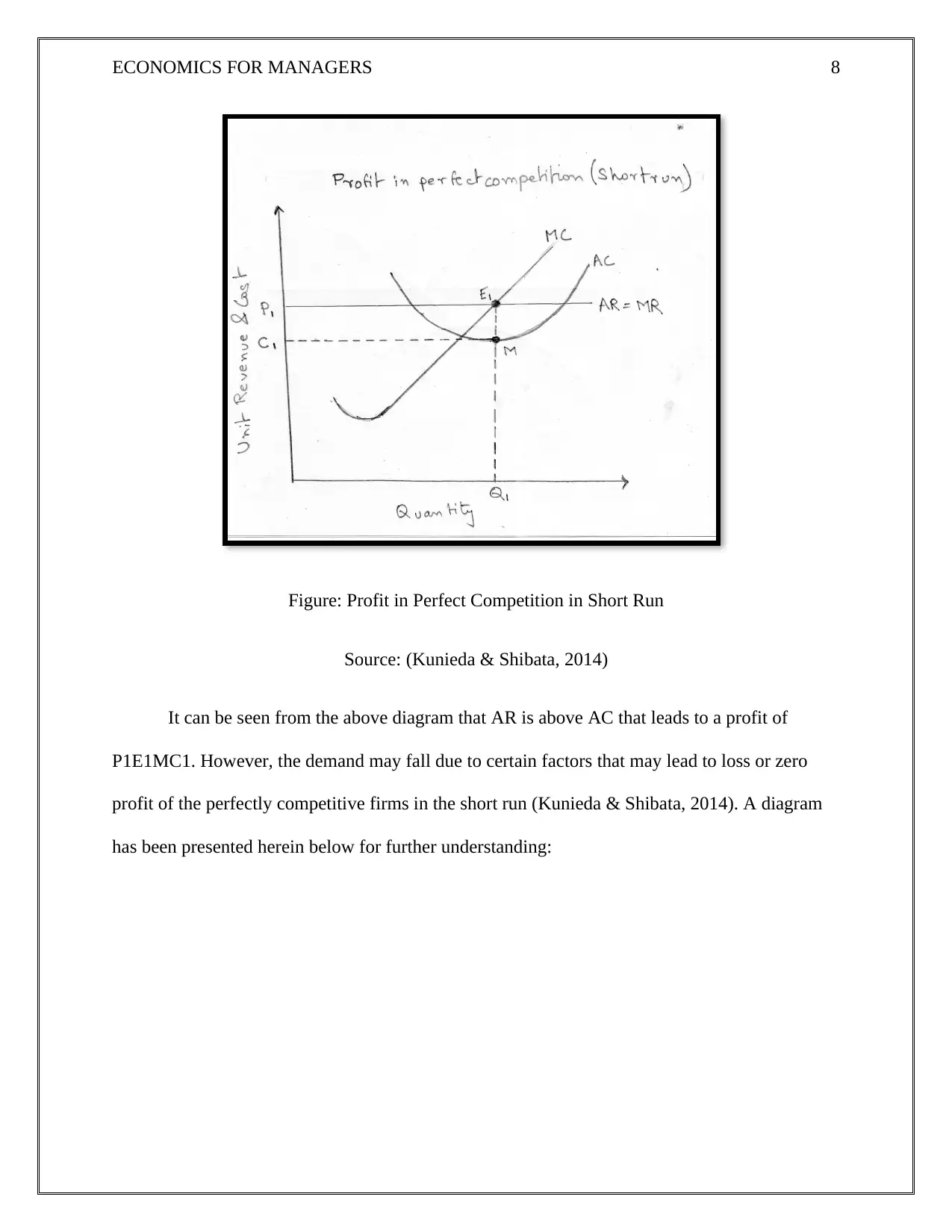
ECONOMICS FOR MANAGERS 8
Figure: Profit in Perfect Competition in Short Run
Source: (Kunieda & Shibata, 2014)
It can be seen from the above diagram that AR is above AC that leads to a profit of
P1E1MC1. However, the demand may fall due to certain factors that may lead to loss or zero
profit of the perfectly competitive firms in the short run (Kunieda & Shibata, 2014). A diagram
has been presented herein below for further understanding:
Figure: Profit in Perfect Competition in Short Run
Source: (Kunieda & Shibata, 2014)
It can be seen from the above diagram that AR is above AC that leads to a profit of
P1E1MC1. However, the demand may fall due to certain factors that may lead to loss or zero
profit of the perfectly competitive firms in the short run (Kunieda & Shibata, 2014). A diagram
has been presented herein below for further understanding:
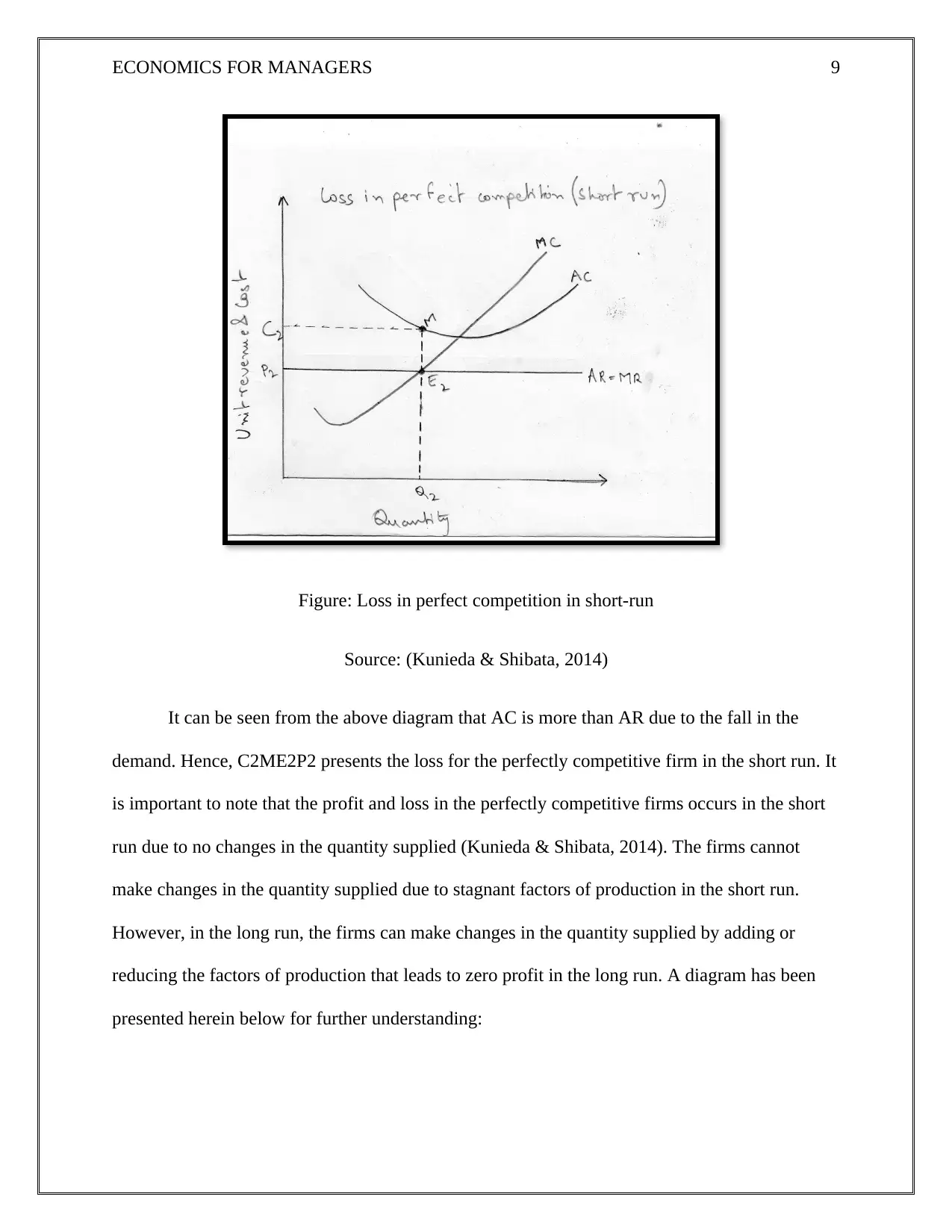
ECONOMICS FOR MANAGERS 9
Figure: Loss in perfect competition in short-run
Source: (Kunieda & Shibata, 2014)
It can be seen from the above diagram that AC is more than AR due to the fall in the
demand. Hence, C2ME2P2 presents the loss for the perfectly competitive firm in the short run. It
is important to note that the profit and loss in the perfectly competitive firms occurs in the short
run due to no changes in the quantity supplied (Kunieda & Shibata, 2014). The firms cannot
make changes in the quantity supplied due to stagnant factors of production in the short run.
However, in the long run, the firms can make changes in the quantity supplied by adding or
reducing the factors of production that leads to zero profit in the long run. A diagram has been
presented herein below for further understanding:
Figure: Loss in perfect competition in short-run
Source: (Kunieda & Shibata, 2014)
It can be seen from the above diagram that AC is more than AR due to the fall in the
demand. Hence, C2ME2P2 presents the loss for the perfectly competitive firm in the short run. It
is important to note that the profit and loss in the perfectly competitive firms occurs in the short
run due to no changes in the quantity supplied (Kunieda & Shibata, 2014). The firms cannot
make changes in the quantity supplied due to stagnant factors of production in the short run.
However, in the long run, the firms can make changes in the quantity supplied by adding or
reducing the factors of production that leads to zero profit in the long run. A diagram has been
presented herein below for further understanding:
⊘ This is a preview!⊘
Do you want full access?
Subscribe today to unlock all pages.

Trusted by 1+ million students worldwide
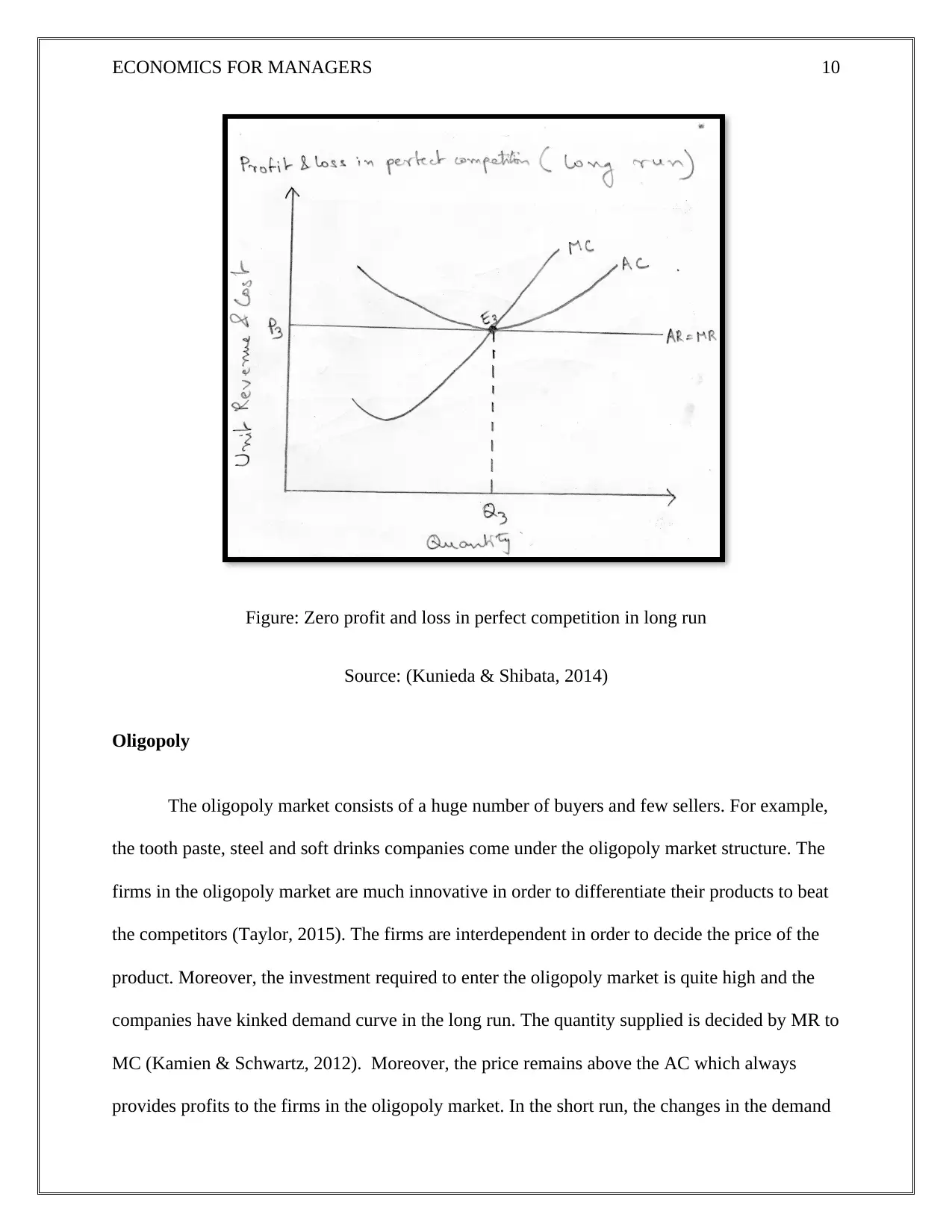
ECONOMICS FOR MANAGERS 10
Figure: Zero profit and loss in perfect competition in long run
Source: (Kunieda & Shibata, 2014)
Oligopoly
The oligopoly market consists of a huge number of buyers and few sellers. For example,
the tooth paste, steel and soft drinks companies come under the oligopoly market structure. The
firms in the oligopoly market are much innovative in order to differentiate their products to beat
the competitors (Taylor, 2015). The firms are interdependent in order to decide the price of the
product. Moreover, the investment required to enter the oligopoly market is quite high and the
companies have kinked demand curve in the long run. The quantity supplied is decided by MR to
MC (Kamien & Schwartz, 2012). Moreover, the price remains above the AC which always
provides profits to the firms in the oligopoly market. In the short run, the changes in the demand
Figure: Zero profit and loss in perfect competition in long run
Source: (Kunieda & Shibata, 2014)
Oligopoly
The oligopoly market consists of a huge number of buyers and few sellers. For example,
the tooth paste, steel and soft drinks companies come under the oligopoly market structure. The
firms in the oligopoly market are much innovative in order to differentiate their products to beat
the competitors (Taylor, 2015). The firms are interdependent in order to decide the price of the
product. Moreover, the investment required to enter the oligopoly market is quite high and the
companies have kinked demand curve in the long run. The quantity supplied is decided by MR to
MC (Kamien & Schwartz, 2012). Moreover, the price remains above the AC which always
provides profits to the firms in the oligopoly market. In the short run, the changes in the demand
Paraphrase This Document
Need a fresh take? Get an instant paraphrase of this document with our AI Paraphraser
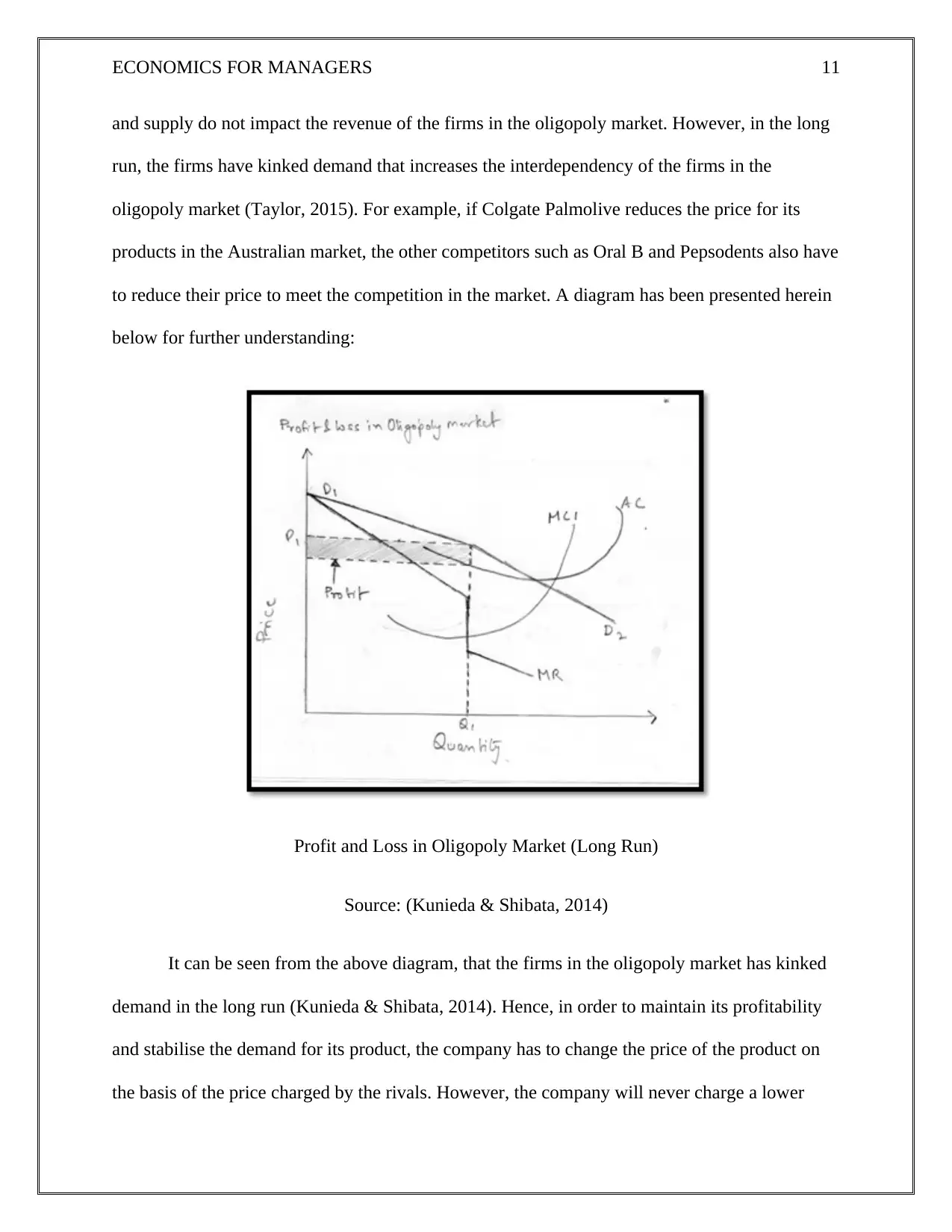
ECONOMICS FOR MANAGERS 11
and supply do not impact the revenue of the firms in the oligopoly market. However, in the long
run, the firms have kinked demand that increases the interdependency of the firms in the
oligopoly market (Taylor, 2015). For example, if Colgate Palmolive reduces the price for its
products in the Australian market, the other competitors such as Oral B and Pepsodents also have
to reduce their price to meet the competition in the market. A diagram has been presented herein
below for further understanding:
Profit and Loss in Oligopoly Market (Long Run)
Source: (Kunieda & Shibata, 2014)
It can be seen from the above diagram, that the firms in the oligopoly market has kinked
demand in the long run (Kunieda & Shibata, 2014). Hence, in order to maintain its profitability
and stabilise the demand for its product, the company has to change the price of the product on
the basis of the price charged by the rivals. However, the company will never charge a lower
and supply do not impact the revenue of the firms in the oligopoly market. However, in the long
run, the firms have kinked demand that increases the interdependency of the firms in the
oligopoly market (Taylor, 2015). For example, if Colgate Palmolive reduces the price for its
products in the Australian market, the other competitors such as Oral B and Pepsodents also have
to reduce their price to meet the competition in the market. A diagram has been presented herein
below for further understanding:
Profit and Loss in Oligopoly Market (Long Run)
Source: (Kunieda & Shibata, 2014)
It can be seen from the above diagram, that the firms in the oligopoly market has kinked
demand in the long run (Kunieda & Shibata, 2014). Hence, in order to maintain its profitability
and stabilise the demand for its product, the company has to change the price of the product on
the basis of the price charged by the rivals. However, the company will never charge a lower
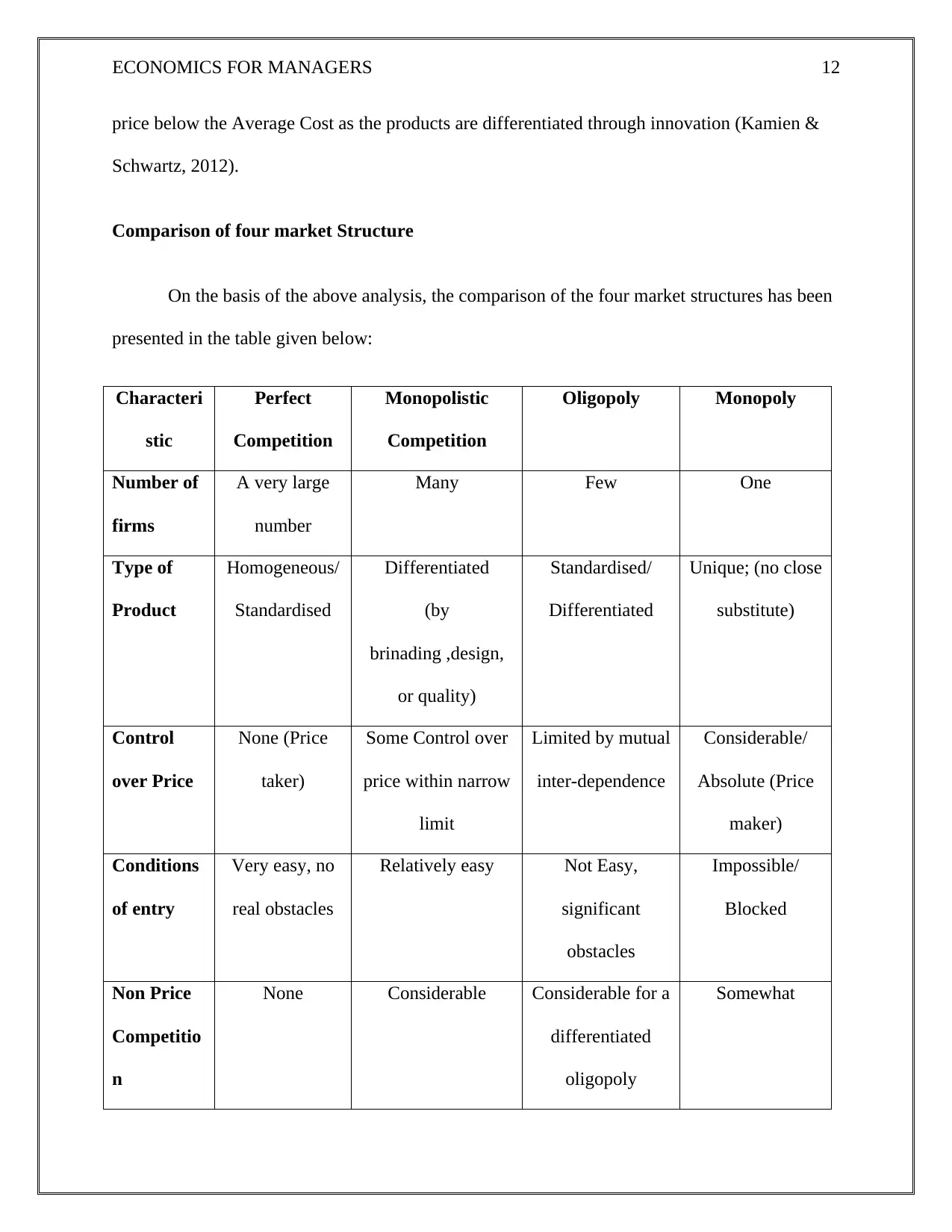
ECONOMICS FOR MANAGERS 12
price below the Average Cost as the products are differentiated through innovation (Kamien &
Schwartz, 2012).
Comparison of four market Structure
On the basis of the above analysis, the comparison of the four market structures has been
presented in the table given below:
Characteri
stic
Perfect
Competition
Monopolistic
Competition
Oligopoly Monopoly
Number of
firms
A very large
number
Many Few One
Type of
Product
Homogeneous/
Standardised
Differentiated
(by
brinading ,design,
or quality)
Standardised/
Differentiated
Unique; (no close
substitute)
Control
over Price
None (Price
taker)
Some Control over
price within narrow
limit
Limited by mutual
inter-dependence
Considerable/
Absolute (Price
maker)
Conditions
of entry
Very easy, no
real obstacles
Relatively easy Not Easy,
significant
obstacles
Impossible/
Blocked
Non Price
Competitio
n
None Considerable Considerable for a
differentiated
oligopoly
Somewhat
price below the Average Cost as the products are differentiated through innovation (Kamien &
Schwartz, 2012).
Comparison of four market Structure
On the basis of the above analysis, the comparison of the four market structures has been
presented in the table given below:
Characteri
stic
Perfect
Competition
Monopolistic
Competition
Oligopoly Monopoly
Number of
firms
A very large
number
Many Few One
Type of
Product
Homogeneous/
Standardised
Differentiated
(by
brinading ,design,
or quality)
Standardised/
Differentiated
Unique; (no close
substitute)
Control
over Price
None (Price
taker)
Some Control over
price within narrow
limit
Limited by mutual
inter-dependence
Considerable/
Absolute (Price
maker)
Conditions
of entry
Very easy, no
real obstacles
Relatively easy Not Easy,
significant
obstacles
Impossible/
Blocked
Non Price
Competitio
n
None Considerable Considerable for a
differentiated
oligopoly
Somewhat
⊘ This is a preview!⊘
Do you want full access?
Subscribe today to unlock all pages.

Trusted by 1+ million students worldwide
1 out of 24
Related Documents
Your All-in-One AI-Powered Toolkit for Academic Success.
+13062052269
info@desklib.com
Available 24*7 on WhatsApp / Email
![[object Object]](/_next/static/media/star-bottom.7253800d.svg)
Unlock your academic potential
Copyright © 2020–2025 A2Z Services. All Rights Reserved. Developed and managed by ZUCOL.





